Pionnier of the underground culture, Basquiat created a new genre: a rich fusion of words, images, and collages. A close friend of Andy Warhol, he imparts a unique sensitivity, often echoing his childhood and his place in society. His artwork “Skull” is a perfect example of a memory translated into painting, full of complexity and mystery that has not been entirely unraveled.
Let’s delve into one of the most legendary paintings by the equally legendary Basquiat, currently showcased at the Fondation Louis Vuitton in Paris.
A Few Words about Jean-Michel Basquiat
The world has been captivated by Basquiat for years. Even before he turned 20, New York galleries already regarded him as a true prodigy. A pioneer of the “underground” period, he particularly disrupted post-expressionism in the 1980s.
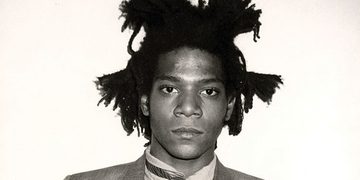
Jean-Michel Basquiat, an American painter born in New York in 1960, was a remarkably precocious child. Of Puerto Rican and Haitian descent, he demonstrated an early interest in reading, words, and even anatomy. When he was just 7 years old, he was struck by a car while playing in the street.
Serious injuries led him to the hospital, and his mother, either to change his thoughts or console him, brought him a copy of the well-known medical manual “Gray’s Anatomy.” A classic that sparked young Basquiat’s passion for the human body, a theme that would continue to punctuate much of his work.
Despite his short life, this artist always displayed audacity and intelligence through his originality. A skillful blend of graffiti, writing, and iconography, all with a backdrop of social engagement. Basquiat passed away at the age of 27, leaving behind more than 800 paintings, 1500 drawings, and a distinctive mark that stands out among thousands.
Untitled, 1981
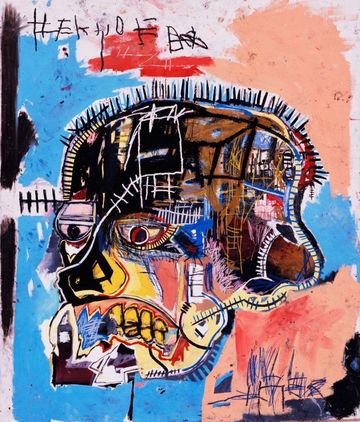
Three Detailed Insights
1. Inside and Outside Simultaneously
Renamed “Skull,” this 1981 artwork is originally titled “Untitled,” like many of Basquiat’s paintings and drawings. It’s clear that beneath the simplistic appearance of a human skull lies a true complexity linked to the nature of our existence. The painting explores the internal/external dichotomy.
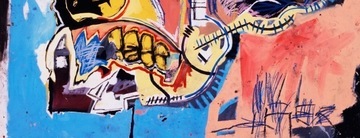
Basquiat employs various techniques in this painting. Acrylic paint is the foundation, to which he added pencil for a truly striking effect. It’s impossible to remain unaffected by this partially decomposed skull!
The magic of the artwork lies in how it evokes a sense of autopsy, with a jaw lacking flesh and a visible skeleton. However, unlike a simple skeletal figure, Basquiat added eyes, ears, a nose, and even hair and facial hair. It presents an external perception of the head.
2. Basquiat Himself?
As with many of his works, Basquiat portrays himself in self-portraits that, at first glance, might lack realism. Indeed, the artist’s style leans more towards sketching than detailed representation.
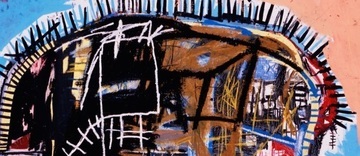
The skull is covered with black skin on the right side, unmistakably reminiscent of the artist himself. Is this his way of projecting himself into the afterlife? Is it an analysis of his own anatomy?
He painted this piece at the age of 20, at the very beginning of a career that would be short but full of promise. If this is indeed a self-portrait, what does it reveal about the artist’s perception of society? Does it evoke issues of race, a topic he addressed through his paintings, naturally questioning the role of the Black community in the American entertainment industry.
3. Ode to Life or Death?
Another intriguing duality lies in the contrast between the vibrant and positive colors surrounding the skull and the deep darkness scattered across the incompletely constructed face. The eyes speak for themselves, revealing a sadness or at least a sense of despondency.
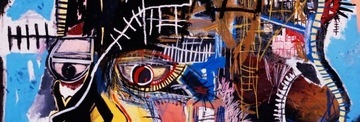
The corner of the mouth is turned down, the eyes are bulging and encased, the teeth clenched. What emotion was Basquiat trying to convey here? One thing is certain: he was obsessed with the idea that he wouldn’t live very long. With this painting, he reveals an internal physiology merged with a conscious psyche.
Sensory organs are present, a partially decomposed skull seemingly ready to live. This reflection was a recurrent theme in the artist’s body of work.
Mastering Inconsistency
The mystery of the inscriptions above the skull and at the bottom right of the painting remains. What message does such a representation convey? Taken separately, the elements of this artwork exhibit coherence: the senses are depicted on one hand, and a self-portrait is suggested on the other.
In addition, there’s the complex study of a skull that seems deceased, though without definitive confirmation. This nearly emaciated face is captivating, fascinating to analyze, even if it carries questions to which the artist never truly responded. Ultimately, the presence of inconsistency doesn’t matter, as it’s carefully controlled throughout Basquiat’s work.
For Basquiat enthusiasts or anyone who would like to experience his works in person, a retrospective is currently being held at the Fondation Louis Vuitton in Paris!




